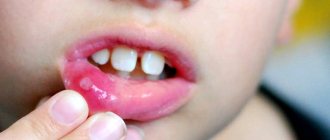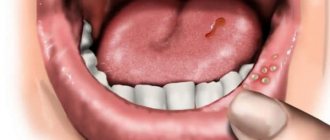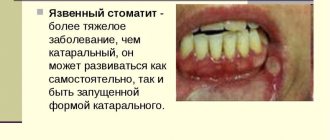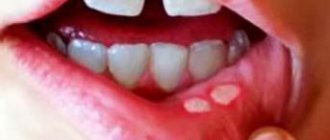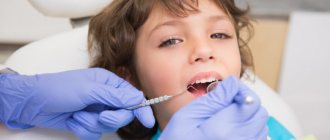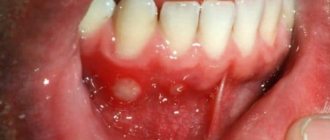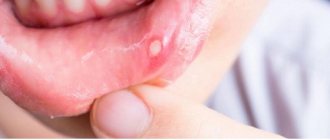Doctor Komarovsky about stomatitis
Every parent is faced with such a very unpleasant and uncomfortable disease for the child as stomatitis. Let's find out the opinion of the famous pediatrician Komarovsky about this disease, as well as how he advises treating stomatitis in children.
If any changes appear in the mouth, Komarovsky recommends that the mother immediately think about what could have led to them. Maybe it was buying a new toothbrush or changing toothpaste, maybe some hard or very hot food or some other factor.
A well-known doctor claims that the main reason for the appearance of stomatitis in a child is associated with changes in saliva - its physical and bactericidal properties. Normally, saliva is constantly produced in the oral cavity to protect the child during contact with the outside world through the oral cavity. And if any factor affects the production of saliva, this can lead to stomatitis.
This factor may be drying out of the oral cavity due to too dry air in the room. And since dehydration and dry mouth appear faster and more often in a child than in an adult, a problem such as stomatitis more often appears in childhood.
A popular pediatrician names among the causes of stomatitis infectious factors (fungi, bacteria, certain viruses), mechanical trauma (biting the cheek, a blow, hard food, some hard object), dirty hands, burns. He also notes that medicine has not yet figured out the causes of aphthous stomatitis, but if a child once has aphthae, they will periodically appear again in the future.
The oral mucosa can be affected by chickenpox, mononucleosis, viral pharyngitis and other infections, but stomatitis can also be an independent disease. Often, damage to the mucous membranes is caused by iron deficiency anemia and vitamin B12 deficiency. Frequent occurrence of seizures can indicate a lack of iron.
According to Komarovsky, stomatitis can manifest itself in different ways - as pinpoint plaques, as blisters, and as small ulcers. Such elements of inflammation can be on the arches of the pharynx, tonsils, inner surface of the cheeks or lips, and tongue. The doctor notes that with the most common aphthous stomatitis, the body temperature does not rise. The mother only notices round ulcers with a yellowish coating and reddened edges in the child’s mouth. As a rule, such ulcers are significantly painful.
Herpetic stomatitis, according to a popular pediatrician, is a highly contagious disease. It usually affects children between the ages of 6 months and 5 years, most often in the first or second year of life. Its most common cause is the transmission of the herpes virus to a child from an adult. Komarovsky calls the features of such stomatitis the presence of high body temperature, as well as the possibility of antiviral treatment.
What is prevention?
To prevent the occurrence of stomatitis in a child, you just need to adhere to the following preventive measures:
- Before each meal, wash your hands thoroughly with soap;
- keep the dishes clean;
- give your child only well-washed vegetables and fruits;
- give water to drink after boiling it;
- eradicate the habit of putting your hands in your mouth;
- give vitamins;
- Maintain good oral hygiene (brushing your teeth at least twice a day plus rinsing your mouth after every meal).
How to treat stomatitis?
If stomatitis appears, you should definitely contact your pediatrician and find out how best to treat the pathology in each specific case. At the same time, Komarovsky notes that almost always the treatment of stomatitis is symptomatic, with the exception of herpetic or staphylococcal stomatitis, when treatment affects the cause of the disease.
Symptomatic therapy helps alleviate the course of the baby’s illness and relieve discomfort, but has almost no effect on the healing time of mucosal lesions. On average, this pathology lasts from 7 to 14 days, unless a bacterial infection occurs.
When treating stomatitis at home, Dr. Komarovsky recommends adhering to the following rules:
- It is important to provide the child with conditions in which the oral cavity does not dry out. To do this, you need to humidify the air in the room and give your baby enough to drink.
- You should constantly ensure that your baby does not become dehydrated.
- All food should be given to the child warm. Its temperature should not exceed +30 degrees. Drinks can be given cold.
- Also, all food that enters the mouth of a baby with stomatitis should be soft. It is recommended to provide a straw for drinking.
- After eating, it is important to rinse your mouth with plain water to remove all food debris from your mouth.
- Juices should be avoided, especially citrus juices. But Komarovsky considers chilled fruit purees to be a good food for stomatitis.
- The popular pediatrician does not recommend using dyes in the treatment of stomatitis. Moreover, if the dye is alcohol-based, this, on the contrary, will lengthen the healing time.
- According to Komarovsky, gels with anesthetics, which are usually used during teething, help reduce the pain of stomatitis.
Herpetic stomatitis in children: little children are sometimes quite troublesome
Often, small ulcers appear on the oral mucosa in children, which bring discomfort in everything - the child eats poorly, sleeps poorly, and is capricious. The cause of this ailment may be herpetic stomatitis, a common type of inflammation of the oral cavity that is caused by the herpes virus. There are several dozen of its varieties. In the human body, the herpes virus can cause damage to the mucous membranes, skin, eyes, nervous and cardiovascular systems.
There are two types of disease: acute herpetic stomatitis and recurrent. The infection is transmitted by airborne droplets or through direct contact. The second type of stomatitis develops as a result of poor quality treatment of the first type. The most common area of manifestation of the virus is the lips, nose, skin around the mouth, and oral cavity. The reason for the appearance of the disease is one ─ infection with a pathogen. At risk are children with chronic diseases, HIV infection, diabetes and other endocrine diseases. The source of infection - the virus carrier - may be other children, relatives, or service personnel. Infection occurs through household items, toys, and airborne droplets. Outbreaks can affect up to 75% of children, the virus is so strong.
Symptoms of herpetic stomatitis
The disease manifests itself in the form of small blisters or ulcers in the mouth, lips, and gums. The rash makes it difficult to eat and communicate.
Herpetic stomatitis in children is accompanied by elevated (up to 39-40C) temperature. In 90% of cases there is no fever, which gives reason to distinguish several forms of this viral disease: severe, moderate and mild.
- A mild degree is characterized by a slight covering of the mucous membrane and skin with small bubbles with a translucent liquid inside, the temperature and lymph nodes are still normal, and the child constantly leaks saliva. This is the most common form; up to 8% of the country's population suffers from this type of stomatitis every year. The mild degree of the disease does not create any discomfort, except aesthetic, and goes away on its own, without medical procedures, after 3 - 4 days.
- The average degree is characterized by low-grade fever (37 - 37.5 C), a significant (compared to the mild form) area of vesicles and ulcers on the mucous membrane of the mouth and lips, the appearance of bleeding and inflammation of the gums, enlargement of the cervical and submandibular lymph nodes, eating is accompanied by itching and burning . The picture of the disease is complemented by general fatigue of the body, weakness, sleep and appetite disorders.
- A severe degree is accompanied by intense fever (up to 40C), extensive inflammation of the oral mucosa and other symptoms characteristic of a moderate degree of viral disease. Catarrhal tonsillitis is likely. On the third - fifth day, the blisters burst, the erosion is covered with a white coating, the wounds gradually clear, epithelialize, and the child refuses food. In such a scenario, it is advisable to call a doctor at home with possible subsequent hospitalization.
If the listed symptoms of herpetic stomatitis are observed in children (possibly even infants), treatment in a hospital is necessary. The time until complete recovery depends on the severity of the disease. Often, herpetic stomatitis complements other diseases, especially colds. Active time is a transitional spring-summer season, promoting hypothermia and weakening of the immune system; the reason may also be the period of rehabilitation after suffering from other diseases, stress.
Recurrent herpetic stomatitis is characterized by frequent manifestations (up to 10 - 12 times a year) and is activated when the immune system is weakened. Such viruses are almost constantly present in the body of almost every person and are suppressed by its defenses. Hypothermia or a mild cold with weak immunity provokes new rashes, especially on the lips. The course of the disease is accompanied by the appearance of ulcers and blisters without other symptoms (fever, inflammation and bleeding of the gums, enlarged lymph nodes, etc.).
Read also: How to treat stomatitis in pregnant women
How to recognize the disease: types and symptoms
The main symptoms of stomatitis in a child include:
- bright red and sometimes fiery color of the oral mucosa;
- deterioration of appetite or its complete absence;
- frequent moodiness, tearfulness;
- small whitish bubbles;
- erosion in the shape of ovals;
- spots covered with a white coating;
- enlarged lymph nodes.
The presence of at least one of the listed symptoms indicates that the baby has stomatitis. However, the disease has several types, each of which has its own symptoms.
Viral stomatitis most often occurs in children aged one to three years. The disease is caused by the herpes virus. In children, the disease is characterized by rapid development. In addition, the disease is contagious, so it is important to identify it as early as possible and begin therapy.
Viral stomatitis can be identified by the presence of the following symptoms:
- hyperthermia up to 39°C;
- vomit;
- dizziness;
- nausea;
- burning, dryness and pain in the mouth;
- increased size of lymph nodes;
- chills;
- moodiness;
- weakness;
- refusal to eat;
- the appearance of vesicles in the mouth, lips and nose.
Allergic stomatitis is rare. Some experts are inclined to believe that it is based on an allergic-type reaction, while others associate its development with dysfunction of the digestive tract. In most cases, the disease affects school-age children.
Appears as:
- various types of rashes;
- dryness of the oral mucosa;
- changes in taste perception;
- redness in the mouth.
The aphthous type of stomatitis most often appears in the spring and autumn periods. A characteristic sign of the disease is aphthae on the baby’s tongue, which subsequently affects the entire oral cavity. These small ulcers are very painful and therefore cause a lot of discomfort for the child. As a rule, they are white, yellow or gray. Around the aphthae there is usually a bright red halo with a clear outline.
After a certain time, the aphthae begin to burst, forming one continuous wound in the child’s mouth. Depending on the advanced stage of the disease, the baby’s temperature may rise and reach 39°C or even higher. Children's aphthous stomatitis is treated from one to three weeks. Its only advantage is that it is not contagious.
Bacterial stomatitis occurs in children of all ages and can be transmitted through close contact. It can be triggered by mechanical or thermal damage to the oral cavity, violations of personal hygiene rules, the appearance of baby teeth, etc. Bacterial stomatitis is of two types: ulcerative-necrotic and catarrhal. The symptoms of the disease are almost the same as for herpetic stomatitis. However, there are also characteristic features:
- thick white coating;
- severe drooling;
- hyperemia;
- marks from teeth on the oral mucosa.
Treatment of herpetic stomatitis
Herpetic stomatitis in children is a pressing issue; according to medical data, 80% of children are familiar with this disease. Most often, the virus affects children aged six months to three years (the mother’s immunity is lost, her own is not formed), and it needs to be treated as early as possible, since stomatitis is quite difficult for children to tolerate. Unfortunately, it is difficult to identify this disease in children in the early stages, since the main symptoms ─ small blisters and ulcers ─ appear only after two to three days.
If there is a malfunction of the immune system, then at the first appearance of ulcers or blisters, the child should be shown to a doctor. It is better to invite a dentist or pediatrician to your home. Lost time contributes to the transition of the disease to a chronic form with the need for hospital treatment. With herpetic stomatitis, photosensitivity may develop, so the sick child should be isolated in a darkened room.
Treatment of herpetic stomatitis in children at home should be aimed at alleviating the child’s condition, healing ulcers, and eliminating the virus. The pediatrician prescribes immunostimulating, antihistamine drugs ─ oxolinic, tebrofen, bonaftone, florenal, interferon ointments and topical preparations ─ disinfection, healing, pain relief and restoration of the mucous epithelium. These can be sprays (Inhalipt, Prosol, Tantum Verde), means for wiping and rinsing the mouth: solutions of furatsilin, methylene blue and borax, soda-salt rinses, decoctions of medicinal plants (chamomile, oak bark, sage), as well as strong tea welding. Rinse procedures should be carried out several times a day, in particular after meals. Sea buckthorn, linseed, and peach oils, as well as rosehip oil, accelerate the healing of wounds.
Dentists recommend avoiding experiments with brilliant green and hydrogen peroxide - burns to the mucous membrane are inevitable. Such a universal medicine as honey can become a catalyst for the disease in this form of stomatitis, as it creates ideal conditions for the proliferation of pathogenic bacteria. Pediatricians warn against the temptation to treat a child only with folk remedies - herpetic stomatitis that is not cured in time has a tendency to relapse and can provoke the development of other diseases. Among modern methods of treating herpetic stomatitis, hardware treatment is used, for example, a helium-neon laser.
An important role in prevention and treatment is given to diet ─ abundant alkaline drinks, crushed, non-irritating food at a comfortable temperature. Exclude spicy, hot, salty, sweet and sour foods from baby food.
During the period of treatment, a sick child must be isolated from children, providing him with separate dishes and personal hygiene products. In the future, to avoid relapses, the child should be regularly shown to the dentist.
Treatment
One thing is clear - the sooner parents notice the symptoms and begin treatment, the fewer ulcers will have time to form in the child’s mouth, which means the child will recover faster and the risk of a severe form will be lower.
Medication
Pathology should be treated with a whole range of drugs.
Herpetic stomatitis is primarily treated by suppressing the herpes virus - drugs based on acyclovir:
- tablets – “Valvir”, “Falvir”, “Acyclovir”;
- ointments - “Zovirax”, “Vivorax”, “Panavir”, “Oxolinic ointment”.
A number of medications with different spectrums of action are also used.
- Children with low immunity are additionally prescribed immunomodulators - Polyoxidonium, Likopid, Derinat.
- For disinfection and as an antiviral treatment, interferon ointment 50%, oxolinic ointment 0.5%, and tebrofen ointment are used.
- To facilitate wound healing for stomatitis, sprays and ointments are prescribed - “Inhalipt”, “Tantum Verde”, “Proposol”, “Lugol”.
- In some cases, antihistamines are also prescribed - Loratadine, Cetrin, Tavegil.
- Anesthetic gels and sprays are prescribed to make eating easier; in addition, they have an antimicrobial and healing effect - “Kamistad”, “Kalgel”, “Baby Doctor”.
- To reduce fever and pain, children with stomatitis are given suppositories with ibuprofen.
- The oral cavity is rinsed with solutions of chlorhexidine or furatsilin.
Folk remedies
In combination with medications, you can use traditional recipes.
- Chamomile decoction: 1 tbsp per 1 cup of boiling water, cook for 10 minutes, then let it brew, strain. Rinse your mouth after every meal or three times a day.
- Aloe A special mixture is prepared for children: chop an aloe leaf, mix with sugar and lubricate the affected areas of the mouth.
- Grate the potatoes on a fine grater, wait until the juice comes out. Apply the pulp to the wounds, do not swallow.
- Decoction of onion peels Grind the onion peels, take 3 tsp, pour 0.5 l. boiling water, stirring, bring to a boil. Remove from heat, leave overnight, strain in the morning. Rinse 2-3 times a day.
- Herbal decoction 1 part birch leaves, 2 parts. sage leaves, 1 part regular motherwort, 3 parts rosehip, pour 10 tbsp mixture of herbs 1 liter. boiled water. Leave for 30 minutes, strain. Rinse your mouth 2-3 times a day.
- Soda Soda has an antimicrobial effect and neutralizes increased acidity in the mouth. If an infant has stomatitis, he will not be able to rinse his mouth, so all the above-mentioned rinses can be carried out using a cotton swab dipped in the selected solution and wipe the affected areas yourself. 1 tsp baking soda in 1 glass of warm water, stir and rinse your mouth every two hours.
Dr. Komarovsky about herpetic stomatitis
A well-known pediatrician believes that a child does not and cannot be diagnosed with stomatitis, since there are many types of stomatitis and not all are treated the same. Cold sores are caused by the herpes virus, starting with severe malaise, headache and pain in the mouth. Children have a very hard time with these fluid-filled rashes.
Principles of treatment of herpetic stomatitis in children at home according to Komarovsky:
- Pain is the main sign of stomatitis, so it is necessary to exclude foods that provoke it - sour, salty, hot.
- The main parental task is pain relief, for example, with lidocaine. If the child is small, lubricate problem areas with a cotton swab; if older, pour a spoonful of 2% solution and rinse the mouth. There are also ready-made ointments for pain relief (for children - Kalgel). As a last resort, suck an ice cube from the refrigerator (but not for small children!).
- There are chewable tablets approved by the Ministry of Health for stomatitis. Do not give any tablets to infants - they easily end up in the respiratory tract!
- If you already know that your child has herpes, from the first minutes start taking antiherpes drugs ─ Zovirax, Famvir, Valtrex; the sooner you start treatment, the faster the recovery will come.
- In addition to painkillers, the child can also be given drugs that accelerate healing ─ aekol, vitamin A (in the absence of allergies).
- A child can get relief even from simply rinsing his mouth with water. The point is that food residues are washed off from the irritated mucous membrane, and what you wash them off with is the tenth thing.
Additional recommendations
- Some stomatitis has not been studied enough, and it is not always possible to establish the exact cause of the disease.
- It’s hard to brush your teeth when you’re in pain, but it’s absolutely necessary. Try to persuade your child, because lack of hygiene can have the most dire consequences, as it can lead to inflammation of the gums, which is much more difficult to cope with.
- If your child has a grayish-green coating on the edge of his gums and a fever, take him to the doctor immediately.
- In case of stomatitis from an injury, you must immediately get rid of the traumatic factor ─ such diseases sometimes turn into cancer.
- Herpetic stomatitis often accompanies scarlet fever, flu, measles, so even if the child is feeling normally, he must be shown to a doctor.
- If you know that your child is prone to developing a “fever” (herpetic stomatitis), do not wait for obvious symptoms. As soon as you see any warning signs of blistering (for example, itching), give your child the medicine right away. The faster, the better (it’s not the days that matter here, but the hours).
- 95% of the world's population are carriers of the herpes virus; science cannot yet rid us of the virus that has entered the body once and for all.
- The appearance of stomatitis of an allergic nature is a reason to abandon the allergen once and for all. Don't joke with allergies!
- Any stomatitis that lasts more than two weeks is a mandatory reason for a return visit to the pediatrician.
Candidal stomatitis
This type of disease most often affects the oral mucosa of newborns. Parents call this stomatitis in children under one year of age – thrush.
The disease belongs to the group of fungal diseases and manifests itself in the form of a characteristic white coating on the tongue and the inside of the baby’s cheeks.
The causes of stomatitis in children are the entry and spread of Candida fungus through the muscle tissue, which is present in small quantities in the mouths of absolutely all people. Under certain circumstances, the fungus multiplies very quickly and infects the oral mucosa.
The main reasons that provoke the occurrence of candidal stomatitis in children:
- Weakening of the body's immune system, the inability to resist the spread of infection;
- An organism unadapted to the environment and unadapted to its conditions. This applies to infants in the first month of life;
- Children suffering from immunodeficiency (HIV);
- Dry mouth caused by dehydration;
- Infection by the mother through breast milk if she is forced to take antibiotics and other groups of medications that dry out the oral mucosa.
To determine this form of stomatitis and prescribe the correct treatment, it is necessary to show the baby to a specialist. He may send you to a laboratory to confirm the diagnosis. With the right treatment, the duration is 5-7 days, after which recovery occurs.
Candidal stomatitis on a child’s tongue practically does not recur, however, if the child has been exposed to a fungal disease once, it is necessary to regularly examine the oral cavity and monitor the microflora.
If you have stomatitis, no matter what pharmaceutical medications your pediatrician prescribes for you, mandatory treatment of the oral cavity with antiseptic agents is necessary. One of the well-known methods of disinfecting ulcers is treating them with iodine-containing solutions.
Iodinol for stomatitis is one of the most effective known remedies, popularly called blue. The drug has virtually no contraindications for use and is suitable for children of all ages. The only caution when using is careful irrigation or rinsing of the mouth to prevent swallowing, since the percentage of iodine in the composition can burn the mucous membrane of the stomach and intestines.
If the child does not know how to rinse his mouth, prepare a weak solution of iodinol and use a spray bottle to gently irrigate the mouth. Possessing a wide antibacterial and antiseptic spectrum of action, this medication copes well with the local treatment of not only fungal and bacterial stomatitis. Iodinol is used to treat sore throats, pustular infections and localized periodontitis.
When stomatitis is first detected in a child, it is necessary to consult a doctor and determine the form and degree of development of the disease. In addition, change the diet and pay attention to the child's hygiene. Introduce more vegetables and fruits rich in vitamins and nutrients into the diet, give your baby more fluids, and do preventative alkaline rinses.
And most importantly, pay attention to increasing immunity. This is a protective property of the body, which in the future can protect the child from many viral and infectious diseases. Lead a healthy lifestyle, follow a daily routine with your baby, and spend more time in the fresh air.
Herpetic stomatitis in children - how to treat and what not to do in such conditions
- If the type of stomatitis has not been definitively established, do not rush to kiss your child (in particular, herpetic stomatitis is contagious). In addition to separate dishes and towels, do not forget about basic hygiene ─ wash your hands often.
- Do not give aerosol with lidocaine 10% to children ─ along with good pain relief, you will get a burn or tightening of the mucous membrane. By the way, young children should not spray aerosol in their mouths in principle!
- Never lubricate with cauterizing drugs (parents like to do this not to themselves, but to their child). In addition to wild pain, there is also the danger of the ulcer degenerating into various bad things.
- Dyes like bluing are also not suitable ─ they are of no use, and the harm is obvious: a blurred clinical picture for the pediatrician, allowing some important things to be missed.
- Maraslavin is a very popular drug among mothers, but the instructions forgot to say that it increases the temperature (extremely undesirable for children) and causes loosening of the gums, so it is simply impossible to brush your teeth at home.
- It is impossible not to note such a popular medicine as Cholisal with a very specific taste and smell. Before use, you should give your child a small dose. If he perceives it normally, you can use it; if not, do not force the child.
Prevention
On average, a child can be contagious for eight days, after which he is no longer so dangerous to others. Strong immunity is the main guarantee of reducing the risk of developing stomatitis. Increasing the body's protective functions is facilitated by taking various immunostimulants, but the main thing is to provide the child with a healthy lifestyle: a balanced diet appropriate for age, adequate sleep, the correct dosage of impressions, active walks, exercise and hardening. The appearance of herpetic stomatitis is a signal from the body about an imbalance, and even after curing the disease, one should not forget about the possibility of relapse, so prevention must be constant. The photo shows herpetic stomatitis in children.
Photo gallery
Varieties of stomatitis are presented in the photo.
Typical shape
Ulcerative form
Deforming form
Lichenoid form
Comments
It's scary to the point of grinding teeth, or what to do if a child grinds his teeth in his sleep The phenomenon of teeth grinding in a dream in children is surrounded by many speculations and superstitions - from infection with worms to the threat of sudden infant death.
What are the actual causes of childhood bruxism and does it need to be treated at all? © 2020 information portal “About Zubki”. Copying materials from this site is permitted only if there is an active indexed link to https://prozubki.com
Read also: How to quickly cure stomatitis on the lip
Editorial site Address: Moscow, st. Snezhnaya, 26
General recommendations
Additional measures will help to quickly cure stomatitis, ease the course of the disease and prevent its early relapse.
- A special diet based on soft foods is prescribed in order to minimize the risk of damage to aphthae and vesicles. You can feed a child with stomatitis vegetable and fruit purees, broths, and pureed soups. Avoid spicy, sour, salty and hot foods.
- During the illness, protect the child from visiting kindergarten or school, provide him with a separate room and cutlery.
- After recovery, get rid of the toothbrush and disinfect the cutlery.
- You should not force your child to eat; refusing lunch with stomatitis is normal; as soon as the ulcers become less painful, the appetite will return.
Stomatitis in children: how to treat, Dr. Komarovsky
Stomatitis is a collective term that refers to inflammatory processes of the oral mucosa in young children. They are united by their localization on the oral mucosa, the ability to spread rapidly, the contact route of transmission and the presence of inevitable inflammation. The disease is differentiated depending on the etiology, nature and duration of its course, the severity of symptoms, and the presence of scars that remain after some forms.
How to treat depends on both general and differentiating factors, the age of the child and the main provocateur. It is generally accepted that stomatitis in children is a pronounced consequence of a failure of still imperfect immunity, and this is clearly confirmed by the fact that after 7 years it practically does not occur. It can be extremely difficult to treat at home, especially if it is caused by a viral or herpetic infection.
Description
Stomatitis is an inflammation of the mucous membranes of the mouth, as well as the outer skin in complex cases - lips, nose. Manifests itself in the form of ulcers, redness, erosions, and blistering formations similar to dropsy. The child experiences pain, burning, is capricious and cries.
You can find out what childhood stomatitis is in the video below.
Children under three years of age and bottle-fed newborns are more susceptible to this disease than others, since their body does not produce the necessary antibodies from mother's milk.
First aid for stomatitis is to consult a doctor. Only a specialist will be able to correctly determine the type of disease, because the symptoms are similar.
Nature of the problem
The method of treatment depends on how long, intense and pronounced the course of stomatitis occurs in a particular child. The famous Russian pediatrician Komarovsky has repeatedly shared his accumulated experience in the treatment of infectious and viral diseases with young parents in his publications. In the field of treating stomatitis in children in the mouth, he has very valuable observations that will help people without medical education figure out how to effectively treat stomatitis, depending on various factors.
Treatment of stomatitis depends on the intensity of the disease
The older generation is still confident that stomatitis in children can be cured using proven folk remedies. But over several decades, not only the strategy and tactics of how to treat have changed, more varieties of the disease have appeared, viruses have mutated, bacteria have changed, new forms of autoimmune diseases and effective drugs have emerged. Therefore, treating a strong virus the old fashioned way is not always rational, especially since some of its varieties appeared quite recently.
The search for effective methods and theories on how to treat stomatitis in children has been undertaken repeatedly over several decades. A revolutionary breakthrough in treatment tactics was made at a time when the development of the inflammatory process was directly associated with weakened immunity.
A vicious circle arises in which medications for some diseases lead to other pathologies due to side effects, and defects in the immune system become independent diseases. The body is no longer always able to resist naturally, and is constantly exposed to viral infectious diseases.
Sometimes stomatitis in the mouth in children is treated quickly, but often its course becomes so pronounced pathological that even an experienced pediatric dentist, who has dealt with more than a dozen patients, wonders how to treat it.
In this matter, the most correct tactic is to differentiate the disease according to the main provocateur, then herpetic and viral stomatitis will be treated by a virologist who is well acquainted with the herpes virus and its other brothers, and an immunologist will tell you how to restore and treat lost immunity in children.
Causes of different types
Today, there are several of the most common forms of stomatitis, which can be differentiated by external signs and the main provocateur:
- aphthous, caused by an allergic reaction, or a pathogenic allergen, the reaction to which was previously extremely negative (in cases of allergies that were inherited or manifested independently);
- herpetic, where the main provocateur is the herpes virus, which can be newly acquired, or present in the body and become more active when the immune system is weakened;
- viral (bacterial) arising against the background of bacteria and viruses of various etiologies present in the body;
- candidiasis, which manifests itself in early childhood as a result of a mycotic infection, often received from the mother during passage through the birth canal;
- angular (cheilitis), which is the result of the transition of a conditionally pathogenic fungus, which is always present in the mouth or on the skin of a healthy person and becomes pathogenic all because of the same weakened immune system, which is no longer able to keep it in its previous status.
Stomatitis can be cured at home
The response to each type of stomatitis, in the form of medications and topical medications, can vary significantly. Manifestations of aphthous stomatitis in children are triggered by various allergens; the answer to the question of how to treat depends on the severity and age of the baby. Success will only occur if the pathogenic agent is reliably identified and can actually be eliminated from everyday life.
If you know exactly how to treat one or another form of the disease in children that is located in the mouth and follow the recommendations of the attending physician, you can do this at home. A typical example in this regard is cheilitis, which is observed mainly in the form of seizures in the corners of the mouth, during the period of spring or winter vitamin deficiency, and is eliminated with an established diet and taking vitamin complexes. It can be easily confused with herpes, because in both cases the provocateur is a virus. But, depending on the duration and stage of development, a different treatment tactic may be chosen. A characteristic feature of angular stomatitis is that it occurs not only in children, but also in adults, under similar external conditions and immune disorders.
Causes of the disease
The causative agents of this disease are staphylococci, streptococci and diplococci. Since the disease is infectious, stomatitis is contagious. In children's groups it has the character of an epidemic.
The causes of aphthous stomatitis in children are the following factors:
- decreased protective properties of the immune system;
- unhealthy diet that does not contain enough vitamins (C, B) and beneficial elements (zinc, iron, selenium);
- mechanical trauma of the mucous membranes;
- genetic disposition;
- burns to the mouth due to consuming hot food or drinks;
- diseases of the gastrointestinal tract and digestive system;
- allergic manifestations;
- stressful situations;
- consequences of past respiratory diseases;
- dental problems in the form of malocclusion, chipped teeth, poor-quality fillings.
Scientists still cannot accurately determine the causes of aphthae, and all of the factors listed are only the most speculative.
Doctor Komarovsky about stomatitis
Known throughout Russia, pediatrician Komarovsky, based on many years of observations and professional experience. believes that the cause of stomatitis lies in various pathological provocateurs that choose the human body as their place of reproduction or residence. This is not the only reason, since hundreds of children do not become infected, but the one hundred and first, even visiting the same children's institution, becomes seriously ill.
Therefore, it would be most logical to assume that the disease develops due to the loss of saliva’s bactericidal and physical properties. According to Komarovsky, it is this factor that becomes, in most cases, the cause of the development of stomatitis. The loss of saliva’s specific characteristics leads to the fact that viruses, infections and fungi not only penetrate into the oral cavity, but also begin active life there, which is no longer prevented by saliva. The doctor can decide how to treat rashes in the mouth.
In this case, the activity of the salivary glands is disrupted, which have lost the ability to produce a specific liquid while maintaining its intended properties. In some cases, folk remedies can be used for therapy, but, basically, they are more suitable as a symptomatic method for eliminating pathology.
The doctor is confident that any factors may be involved in the loss of bactericidal properties of saliva, including:
- as simple and easily explained as the appearance of involuntary scratches from solid food, seeds, chewing nuts, etc.;
- low-quality toothpaste, use of a questionable elixir for rinsing, improper brushing of teeth with a too hard brush, braces, teething;
- burns of the mucous membrane from too hot food and drinks, biting the cheeks;
- infection due to non-compliance with intimate hygiene rules.
It is important to maintain good oral hygiene in children
All this leads to damage to the mucous membrane, forming microscopic wound surfaces into which pathogenic microbes and viruses penetrate to carry out their vital functions. Some of them could be destroyed by saliva, but it lost its bactericidal properties, so they were given full scope for their activities. The appearance of fungal colonies, or herpetic plaques, is the result of the close interaction of these factors. It is not without reason that many manifestations of stomatitis occur against the background of:
- recent viral or bacterial processes;
- atypical for childhood (but quite probable) - tuberculosis, gonococci, diphtheria and syphilis;
- absolutely normal for the early period, the development of chickenpox, measles, influenza and rubella;
- hereditary predisposition and premature birth;
- vitamin deficiency, anemia, nervous exhaustion or taking incorrectly selected medications.
One factor is enough – and stomatitis begins to develop. A very favorable reason is the presence of viruses and bacteria. But without the loss of the disinfecting properties of saliva and microdamage to the oral cavity, the disease would not have begun to develop.
Read also: Soda solution for stomatitis in children
Treatment of stomatitis according to the recommendations of a Russian pediatrician
Evgeny Komarovsky is sure that the treatment of stomatitis is not so much the prerogative of the dentist as of the pediatrician.
If a dermatologist or mycologist helps in treating a fungal infection, this will only benefit the treatment process when candidiasis or angular stomatitis is present.
It is necessary to restore the child’s natural immunity
An immunologist and a virologist can be involved in therapy. But the main treatment should occur in several directions at once:
- restoration of the natural immunity of the child’s body with the help of proper nutrition, vitamin complexes, physical activity, fresh air and immunomodulators;
- a thorough medical examination and identification of concomitant diseases that must be cured;
- qualified mouth treatment, rinsing, use of ointments, sprays and folk remedies for disinfection;
- drug treatment - taking painkillers for intense pain, antiviral drugs, and, if necessary, drugs that enhance microcirculation and mucosal regeneration;
- compliance with hygiene standards, frequent hand washing, when breastfeeding - treatment of nipples, pacifiers and bottles;
- selection of the correct dental and oral care products;
- eliminating potential allergens and taking, if necessary, antihistamines if we are talking about aphthous stomatitis.
Dr. Komarovsky also gives some advice on oral care. In his opinion, the air that the child inhales indoors plays a huge role in the condition of the nasopharynx. It should not be too warm or dry. Optimal air temperature is +18, humidity – 60-70%. The children's room should be well ventilated, without significant foreign odors and potential sources of dust. This will ensure the normal condition of the nasopharynx.
The oral cavity during this period needs special care, so you need to rinse your mouth after eating any food, give your baby plenty of fluids, but exclude juices and heat pureed or soft food to body temperature. It should be neither warm nor cold, and in no case hard. If stomatitis is accompanied by severe pain, you can use gels containing an anesthetic.
Such drugs have relatively recently appeared in pharmacies for use in teething. The correct general tactics, and compliance with the specific treatment of stomatitis, if its provoking factor is definitely established, will help to quickly and effectively get rid of the negative process.
Komarovsky stomatitis treatment
Circumstances of origin of stomatitis. Especially quite often it is possible to encounter herpetic and aphthous stomatitis. We wrote about this in our article: Treatment of stomatitis with folk remedies. Stomatitis is a common disease, especially in preschool children. Stomatitis in most cases goes away within 14 days. Based on this, it is fundamentally important not to make a mistake in diagnosing the form of stomatitis, and in order for the correct diagnosis to be made, it is better to consult a doctor, despite the fact that the treatment itself can be carried out at home.
Stomatitis itself indicates an inflammatory disease of the mucous membrane of the oral cavity. Stomatitis on the tonsils can be either the result of a disease or a prerequisite for pathology of the gastrointestinal tract, immunodeficiency, leukemia and other diseases of an infectious-allergic nature. If any signs of this disease appear, you should immediately consult a doctor, because from time to time it takes on the temperament of a chronic disease.
In addition, vitamins and anti-inflammatory drugs are prescribed in the complex. But even this is not enough. Sanitation of the oral cavity is a mandatory requirement. Sanitation can be carried out both in the clinic and at home. The procedure is a rinse of the mouth. It is completely painless and at the same time effective. The doctor uses a special syringe filled with an antiseptic drug and a nozzle. At home, it is possible to carry out this procedure yourself, using a solution of chlorophyllipt, a decoction of various herbs, and others as an antiseptic.
Video
Dr. Komarovsky, in his series of programs about children’s health, tells how to deal with aphthous stomatitis and what measures to take to prevent it. Filmed by the “Doctor Komarovsky” channel.
Do you have any questions? Specialists and readers of the KROHABABY website will help you ask a question
Was this article helpful?
Thank you for your opinion!
The article was useful. Please share the information with your friends.
Yes (100.00%)
No
X
Please write what is wrong and leave recommendations on the article
Cancel reply
Rate the benefit of the article: Rate the author ( 1 vote(s), average: 5.00 out of 5)
Discuss the article:
Stomatitis - treatment for adults at home
When doing this procedure at home, you may need the help of someone in your household. But adults also suffer from it. 1. Viral infection. In most cases, the herpes virus. The ulcers are painful, making it difficult to chew and swallow with stomatitis.
In addition, the submandibular lymph nodes increase. You can read about methods of fighting herpes in our material How to treat herpes at home. 3. Bacterial - appears when bacteria enter the wound after any injury. 4. Erosive-ulcerative – characterized by the appearance of very painful blisters with clear liquid. Much more often accompanied by high fever and weakness. 5. Allergic is a reaction to a specific allergen that enters the oral cavity.
Stomatitis on the tonsils: diagnosis and treatment
In most cases, it is enough to repeat this procedure three days in a row. Use for rinsing. 7. Rinse with chamomile infusion. 1. Personal towels, dishes, bedding. 3. Taking vitamins. 4. High-quality and rational nutrition. Did you like the article? When reading the article, pay attention to the symptoms of each form of stomatitis, because... In the treatment of different forms of stomatitis, completely different drugs are used. But in adults, in most cases, these symptoms are not too pronounced.
At the same time, rashes may appear on the red border of the lips and the adjacent skin. In Fig. 7-9 you can see a photo of gingivitis, which in most cases accompanies herpetic stomatitis. This form of stomatitis is nothing more than viral stomatitis, which is caused by the herpes virus.
The circumstances for the development of the disease can be different: hypothermia, stress, complications after scarlet fever, measles, diphtheria, etc. The presence of carious teeth, poor oral hygiene, smoking are favorable factors for the development of the disease. In most cases, the disease proceeds without sudden surges of pain over a long period of time.
Herpetic stomatitis in adults: treatment
Then the disease intensifies and severe pain appears in the oral cavity, and bad breath develops (pungent, putrid). In any case, it is better to prevent consequences than to treat them. Removal of ulcers on the mucous membrane is the first stage of treatment; much more often antibiotics such as ampiox, penicillin, etc. are used. The antibiotic is strictly prescribed by the doctor, as is its dosage. In addition, the syringe can be replaced with a cotton pad, dipping it into the solution. On the mucous membrane of the mouth, small round or oval ulcers of a white or grayish tint appear on the inside of the cheeks, lips, palate, tongue, and tonsils.
